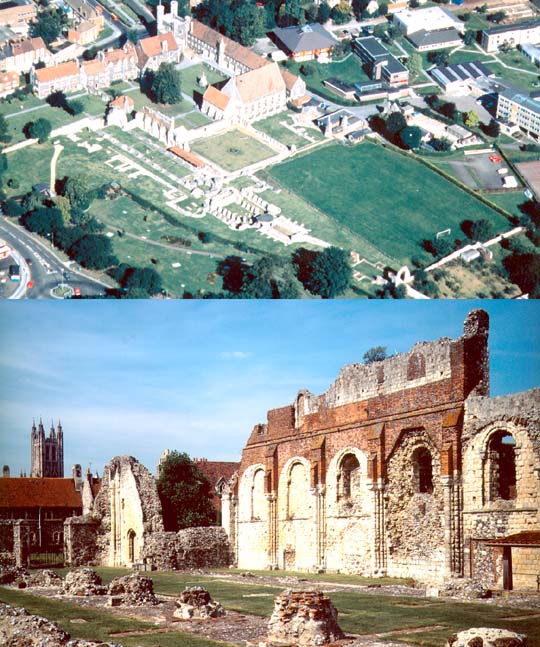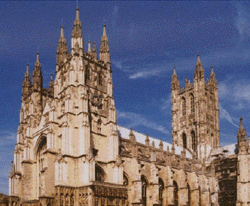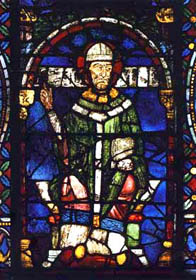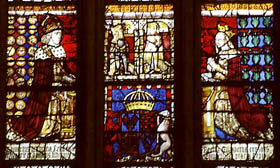CANTERBURY
Canterbury and Kent were both named after the prehistoric
tribe, the Cantii, who inhabited the region. Canterbury was one of the
first sites fortified by the Romans when they invaded Britin in 43 A.D.
They  evacuated
the area in 410, and Saxon invasions followed shortly. In 580 the
Saxon king, Ethelbert, married Queen Bertha, a Christian, and was convinced
by his wife to found two churches, Christ Church (later Canterbury Cathedral)
and the Abbey of St. Augustine, named after the missionary who arrived
there in 597. Thus, the mother church of England is at Canterbury.
evacuated
the area in 410, and Saxon invasions followed shortly. In 580 the
Saxon king, Ethelbert, married Queen Bertha, a Christian, and was convinced
by his wife to found two churches, Christ Church (later Canterbury Cathedral)
and the Abbey of St. Augustine, named after the missionary who arrived
there in 597. Thus, the mother church of England is at Canterbury.
 After
the Norman invasion, William the Conqueror had two castles built in Canterbury
(c. 1090). The cathedral was destroyed by fire in 1067 and was rebuilt
(the oldest extant parts of the cathedral today date from the Norman period).
The dormitory in the cloisters also dates from c. 1070. Architectural styles
in the church include Norman, Early English, Decorated (1170's, designed
by William of Sens. Sens was where Becket lived in exile), and Perpendicular.
After
the Norman invasion, William the Conqueror had two castles built in Canterbury
(c. 1090). The cathedral was destroyed by fire in 1067 and was rebuilt
(the oldest extant parts of the cathedral today date from the Norman period).
The dormitory in the cloisters also dates from c. 1070. Architectural styles
in the church include Norman, Early English, Decorated (1170's, designed
by William of Sens. Sens was where Becket lived in exile), and Perpendicular.
 The
martyrdom of Thomas Becket in 1170 (29 December) turned Canterbury into
a boom town, and pilgrims coming to worship at Becket's shrine brought
great wealth to the area. A corona or rounded chapel was built at the East
end of the church to keep the top of Becket's head which the four knights
had cut of
The
martyrdom of Thomas Becket in 1170 (29 December) turned Canterbury into
a boom town, and pilgrims coming to worship at Becket's shrine brought
great wealth to the area. A corona or rounded chapel was built at the East
end of the church to keep the top of Becket's head which the four knights
had cut of f. Henry
II who had incited the murder was forced to do penance, coming to Canterbury
wearing a hair shirt and no shoes where he was scourged by the monks.
Chaucer's 14th c. "Canterbury Tales" reflect the medieval importance of
the shrine. In 1471 Edward IV made Canterbury a county borough,
the smallest in England.
f. Henry
II who had incited the murder was forced to do penance, coming to Canterbury
wearing a hair shirt and no shoes where he was scourged by the monks.
Chaucer's 14th c. "Canterbury Tales" reflect the medieval importance of
the shrine. In 1471 Edward IV made Canterbury a county borough,
the smallest in England.
The advent of the English Reformation led to the dissolution
of the monasteries and the destruction of Thomas Becket's tomb. Thomas
More's daughter, Meg Roper, lived in Canterbury, and after her father was
executed she brought his heart back to the Cathedral where it was entombed.
Canterbury was a royalist town during the English Civil
War and as a consequence, when Cromwell came to power he demolished much
of the city wall. After the Restoration of the monarchy, Charles
II spent his first night in Canterbury.
Although there are numerous references to various monarchs
throughout the cathedral, including stained glass windows featuring Richard
II and Edward IV, Henry IV is the only king buried in Canterbury.

 evacuated
the area in 410, and Saxon invasions followed shortly. In 580 the
Saxon king, Ethelbert, married Queen Bertha, a Christian, and was convinced
by his wife to found two churches, Christ Church (later Canterbury Cathedral)
and the Abbey of St. Augustine, named after the missionary who arrived
there in 597. Thus, the mother church of England is at Canterbury.
evacuated
the area in 410, and Saxon invasions followed shortly. In 580 the
Saxon king, Ethelbert, married Queen Bertha, a Christian, and was convinced
by his wife to found two churches, Christ Church (later Canterbury Cathedral)
and the Abbey of St. Augustine, named after the missionary who arrived
there in 597. Thus, the mother church of England is at Canterbury.
 After
the Norman invasion, William the Conqueror had two castles built in Canterbury
(c. 1090). The cathedral was destroyed by fire in 1067 and was rebuilt
(the oldest extant parts of the cathedral today date from the Norman period).
The dormitory in the cloisters also dates from c. 1070. Architectural styles
in the church include Norman, Early English, Decorated (1170's, designed
by William of Sens. Sens was where Becket lived in exile), and Perpendicular.
After
the Norman invasion, William the Conqueror had two castles built in Canterbury
(c. 1090). The cathedral was destroyed by fire in 1067 and was rebuilt
(the oldest extant parts of the cathedral today date from the Norman period).
The dormitory in the cloisters also dates from c. 1070. Architectural styles
in the church include Norman, Early English, Decorated (1170's, designed
by William of Sens. Sens was where Becket lived in exile), and Perpendicular.
 The
martyrdom of Thomas Becket in 1170 (29 December) turned Canterbury into
a boom town, and pilgrims coming to worship at Becket's shrine brought
great wealth to the area. A corona or rounded chapel was built at the East
end of the church to keep the top of Becket's head which the four knights
had cut of
The
martyrdom of Thomas Becket in 1170 (29 December) turned Canterbury into
a boom town, and pilgrims coming to worship at Becket's shrine brought
great wealth to the area. A corona or rounded chapel was built at the East
end of the church to keep the top of Becket's head which the four knights
had cut of f. Henry
II who had incited the murder was forced to do penance, coming to Canterbury
wearing a hair shirt and no shoes where he was scourged by the monks.
Chaucer's 14th c. "Canterbury Tales" reflect the medieval importance of
the shrine. In 1471 Edward IV made Canterbury a county borough,
the smallest in England.
f. Henry
II who had incited the murder was forced to do penance, coming to Canterbury
wearing a hair shirt and no shoes where he was scourged by the monks.
Chaucer's 14th c. "Canterbury Tales" reflect the medieval importance of
the shrine. In 1471 Edward IV made Canterbury a county borough,
the smallest in England.
